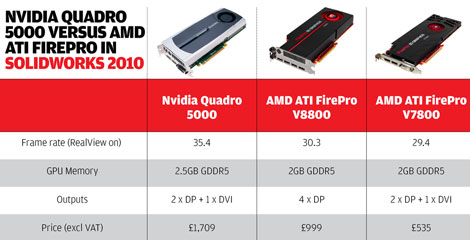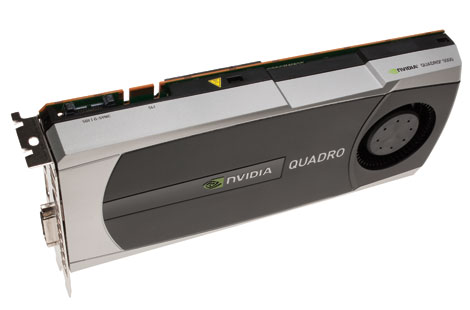
Nvidia’s new Quadro 5000 features 2.5GB GDDR5 memory
It’s been a long time coming, but today at Siggraph 2010 Nvidia unveiled its brand new family of Quadro professional graphics cards based on its Fermi architecture. There are currently three new cards in the range: the high-end Quadro 4000 (2GB GDDR5 memory) and Quadro 5000 (2.5GB GDDR5 memory) and the ultra high-end Quadro 6000 (6GB GDDR5 memory). These will replace the Quadro FX 3800, Quadro FX 4800 and Quadro FX 5800, Nvidia’s previous generation cards.
As is traditional for new Quadro launches, Nvidia starts at the high-end and works down so if you were wondering where the entry-level and mid-range cards are expect these to be announced later this year.
In terms of availability, Nvidia said that the Quadro 4000 and Quadro 5000 will ship in the August timeframe, whereas the Quadro 6000 will be not be out until September / October because of its high capacity memory modules not yet being available.
For those interested in the all important bottom line, the new Fermi Quadro cards don’t come cheap, with the Quadro 4000, 5000 and 6000 having an estimated RRP of £779, £1,709 and £3,579 respectively. In the case of the Quadro 4000 and 5000 this is largely down to both cards also having dedicated High Performance Computing (HPC) features in addition to their core use as a graphics card.
With a major focus of the new Fermi architecture being on GPU compute (calculating non-graphical computational tasks traditionally carried out by CPUs) both the Quadro 4000 and 5000 feature ECC (Error Correcting Code) memory and double precision for increased accuracy in Computer Aided Engineering (CAE) calculations.
While we expect the importance of GPU compute to grow in the coming year, for most CAD/CAM/CAE users Nvidia Quadro is all about accelerated 3D graphics under OpenGL and DirectX. For the past couple of days we’ve been putting the Quadro 5000 through its paces, under a couple of CAD applications, namely Inventor Professional 2011 (DirectX), and SolidWorks 2010 (OpenGL), and comparing the results to those from AMD’s recently released ATI FirePro V8800 (2GB GDDR5) and V7800 (2GB GDDR5). Our test workstation was an IPW-Ci7 from InterPro workstations, sporting an Intel Core i7 970 (6 x 3.20GHz) CPU and 6GB DDR3 1,333MHz memory.
Despite having a brand new graphics engine we found that Inventor 2011 is still very CPU limited (meaning that the CPU becomes the bottleneck before the graphics card can express its true power), which doesn’t lend itself well to testing high-end graphics cards so we concentrated on SolidWorks 2010 to assess the credentials of the new card. With an average frame rate of 35.4 the Quadro 5000 was approximately 15% faster than the ATI FirePro V8800, a significant amount in any benchmark, and a good indication of where Nvidia is going with Fermi. However, with the Quadro 5000 costing significantly more than the AMD card, the FirePro V8800 certainly win hands down when it comes to price/performance.

Benchmark showing the performance of the new Nvidia Quadro 5000 under SolidWorks 2010
While both the Quadro 5000 and FirePro V8800 will mainly interest users of high-end CAD, digital mockup and design visualisation software – and judging them solely on their performance in SolidWorks 2010 would be wrong – the real interest for the CAD/CAM/CAE market is likely to come from the Quadro 4000 and the yet to be announced new mid-range and entry-level Quadro cards. In this highly competitive market, price/performance continues to be an extremely important metric and here the £779 price tag that Nvidia has put on the Quadro 4000 will put it right up against the FirePro V7800 (£535) and FirePro V8800 (£999). We look forward to testing one soon.
Meanwhile, for more details on the new Fermi Quadros and how Nvidia is starting to crank things up for GPU compute, we’ve a full report from an engineering roundtable event that we attended in Bonn, Germany at the end of May. Under embargo until now, there was some very cool software on show that used multiple GPUs to accelerate the calculations. For interactive ray tracing with all the complex calcs carried out on Nvidia’s CUDA-based GPU hardware there was DeltaGen from RTT and a forthcoming version of Catia V6 from Dassault Systemes. We were also privy to a new CFD development from FluiDyna and RTT that calculates and displays airflow in real time. Meanwhile, exploring the use of GPUs for running complex Computer Aided Engineering (CAE) calculations, Nvidia also gave some insight on the future of mainstream simulation software with news on Ansys, MSC.Software and Simulia.






